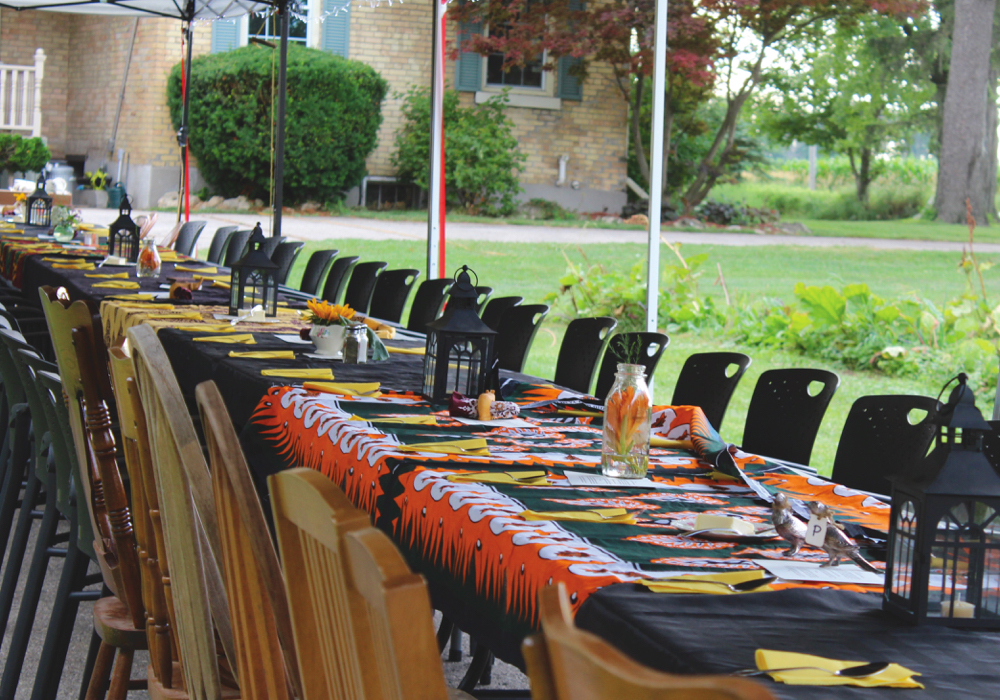Here is one thing you can do that will help your kids succeed in school and life, and it’s as simple as making it a habit to eat together as a family. It sounds too good to be true, but true is exactly what it is.

That’s according to Dr. Anne Fishel, a family therapist in Cambridge, Massachusetts, who should know. The author of Home for Dinner, Fishel literally wrote the book on healthy family meals.
She is also the co-founder of the Family Dinner Project, a non-profit organization that aims to help families have more fun, more meaningful conversations and healthier family dinners.
Fishel says the research is very compelling. When it comes to physical health, home-cooked meals tend to be better for us than restaurant or take-out food. Home-cooked meals are lower in fat, sugar and salt, and kids who eat at home consume more fruit, vegetables, fibre and vitamins than kids who eat out.
Studies have also shown that dinner conversations are better boosters of a child’s vocabulary and reading ability than even reading to your kids. And whether or not a child regularly eats dinner with their family is a better predictor of their academic performance than doing homework.
Read Also

Employment Agreements Can Help Protect Your Farm
N/A
Teenagers who regularly eat dinner with their families are less likely to have high risk behaviours such as substance abuse, they are less likely to be violent, and they are less likely to suffer from anxiety and depression.
And even after children leave home, the protective effects continue, with young adults less likely to be obese and more likely to eat healthily.
Fishel is only half-joking when she says that if more families ate dinner together, her counselling practice would go out of business.
Yet while eating meals as a family sounds simple, in reality it can be tough to do on a regular basis. Fishel says surveys show only about half of families eat dinner together five or more times each week. With the pressures of field work, equipment breakdowns, off-farm work, kids’ activities, elder care and volunteer commitments, finding a time when all family members can sit down together for a meal at home can be challenging (continued below).
Managing conflict at the table
5 Tips from “Home for Dinner” by Dr. Anne Fishel
- Have your difficult conversations somewhere else, not at the supper table.
- Go easy on teaching manners at the table.
- Set some guidelines for conversation, if necessary, such as “only one person speaks at a time” or “we’re not going to interrupt each other.”
- To prevent complaints about the food, which is one of the greatest sources of conflict at the table, create a list of acceptable meals that everyone agrees to eat without whining.
- Set and adhere to rules for using phones or other technologies at the table.
Fortunately, the positive effects of shared family meals aren’t limited to dinner. With a little creativity, you may be able to find more ways to bring family members together for sustenance. It could be breakfast after the morning chores are done, an after-school snack, or even a bedtime snack.
Fishel says that any block of time you set aside to be together to connect with one another will suffice. During harvest, it can even be a picnic on the truck tailgate.
While the research is based on eating together at least five times a week, Fishel anticipates there would still be advantages if it was less often. The power of family comes from the quality of conversation around the dinner table. It’s a time when families can tell stories about the things that happened to them, seek advice about how to handle challenges that came up that day, or talk about issues going on in the world. The dinner table can also be a place to seed important family values and promote a sense of belonging.
With a lack of time being the No. 1 reason families cite for not eating together on a regular basis, Fishel shares some tricks that help make it easier to get a healthy meal on the table in a hurry.
Use shortcuts. You could pick up a grocery store rotisserie chicken and then make a healthy salad to go on the side. The carcass can be used to make a healthy chicken soup the next night.
Make double batches and freeze half so you have an extra meal for a night when you don’t have time to cook.
Swap meals with friends. If four of you each make a quadruple batch of a favourite meal, then you have three meals to swap with each other.
Serve quick foods for supper. Eggs, pancakes with fruit, or soup and salad make healthy but quick meals.
If satisfying multiple tastes is a problem, choose build-your-own meals such as mini-pizzas or tacos.
Older children and teens can be involved in menu selection, preparation and cleanup. If teens are reluctant to eat at the table, have them create a music playlist, ask them how a recipe could be improved, or find out what conversation topics are out of bounds. You don’t need to bring up a teen’s poor score on a math test at the table, says Fishel.
And while getting everyone around the table is half the battle, modern technology may prevent family members from truly connecting with one another at meal times even though they are physically present.
Phones and other screens should be used judiciously at the table. Screens prevent face-to-face connection during the meal. In fact, surveys have shown that parents tend to be the worst offenders.
Fishel recommends putting phones away but says some families will allow them solely for the purpose of sharing a funny text or photo or for Googling to settle a dispute.
Perhaps the most important thing you need to do to make family meals a reality is to prioritize them. Fishel estimates it only takes an hour to make, eat and clean up from a family meal, asking “What else can we do that takes only an hour a day but packs such a big punch?”
Fish Tacos (for 4)
This recipe was created by the son of Dr. Anne Fishel to recreate a version he ate from a food truck. Dr. Fishel says re-creating a dish at home that you’ve tasted at a restaurant (or food truck) can be fun — a great shared activity.
- 2 tablespoons white or champagne wine vinegar
- 1 tablespoon sugar
- 1/2 teaspoon salt
- 1/2 red onion, thinly sliced
- 1 pint cherry tomatoes
- 1/2 red onion, finely diced
- Juice of 2 limes
- Salt and pepper
- 1 avocado
- 1/4 cup mayonnaise
- 1 teaspoon lime juice
- 1 cup all-purpose flour
- Cayenne pepper to taste
- 1/4 cup canola oil
- 1 pound cod fillets or other firm white fish
- 1 (8-count) small package soft corn tortillas
Mix the vinegar, sugar, and salt in a small bowl. Pour the mixture over the sliced red onions and let sit for at least one hour. This sets up a very quick pickling process.
Halve the cherry tomatoes and combine them in a bowl with the finely diced red onions, the juice of two limes, salt, and pepper. (If you’re feeling adventurous, add a small chopped jalapeño pepper, with seeds and ribs removed.)
Scoop out the avocado and mash it with a fork in a small bowl. Add the mayonnaise to the avocado, and mix until creamy. Season with 1 teaspoon lime juice and salt and pepper to taste.
Combine the flour, salt and pepper, and cayenne pepper in a shallow baking dish or high-rimmed plate. Slice the cod into 3-inch-long chunks. Dredge the fish in the flour mixture. Be sure to remove any clumps of flour that adhere to the fish, since these will just burn in the pan.
Heat the canola oil in a frying pan over high heat. (Don’t be afraid of cranking up your stove to the highest flame and watching the oil smoke.) Place the cod into the pan, making sure not to overcrowd it, which will bring down the temperature in the pan. Fry for two minutes on each side. Any more will dry out the fish and make it rubbery.
Just before serving, heat the tortillas in a dry saucepan over low heat.
Now it’s time to assemble the tacos. Spread the avocado cream in a thin layer on each tortilla shell. You’ll need two tacos per person. Place a piece of cod on the avocado spread. Top the fish with the cherry tomato salsa and pickled onions.
Frittatas (for 4)
Frittatas can make a quick supper. Recipe reprinted with permission from Home for Dinner by Dr. Anne Fishel
- 8 large eggs
- 1/4 cup milk
- Salt and pepper to taste
- 2 tablespoons oil or butter
- 3 cups vegetables (any combination of onions, asparagus, red pepper, scallion, cherry tomatoes, mushrooms, or whatever else you have on hand)
- 1/3 cup shredded Parmesan, cheddar, or Swiss cheese
Crack the eggs in a large bowl and whisk with milk, salt, and pepper.
In an all-metal skillet, heat the oil or butter, and then add the vegetables. Sauté for 5 to 10 minutes, or until the vegetables are softened.
Pour the egg mixture over the vegetables, and let this concoction sit over moderate heat until it looks mostly cooked through — less than 5 minutes. Sprinkle the cheese over the egg mixture, and place the pan in the oven under the broiler for about 5 minutes, or until it looks golden. When you remove the pan from the oven be sure to use a pot holder.
Serve the frittata with a hunk of bread and a salad, and you’ll have a healthy, cheap meal made in less than 20 minutes.
Resources
Home for Dinner: Mixing Food, Fun and Conversation for a Happier Family and Healthier Kids by Anne K. Fishel (American Management Association, 2015)
Food, Fun and Conversation: 4 Weeks to Better Family Dinners (free online program).
More ideas for quick meals: Food Bloggers of Canada “On Board in 20” recipe series.
















